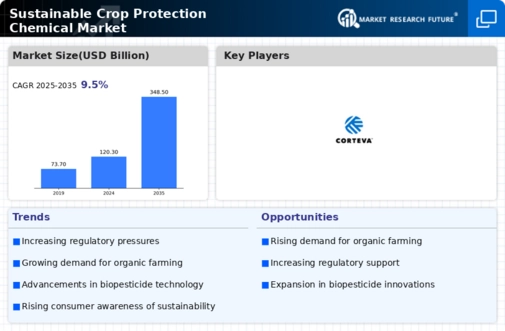Market Growth Projections
The Global Sustainable Crop Protection Chemical Market Industry is projected to experience substantial growth in the coming years. With a market value of 120.3 USD Billion in 2024, the industry is expected to expand significantly, reaching an estimated 348.5 USD Billion by 2035. This growth reflects a compound annual growth rate of 10.15% from 2025 to 2035. Such projections indicate a strong shift towards sustainable agricultural practices, driven by consumer demand, regulatory support, and technological advancements. The market's trajectory suggests a promising future for sustainable crop protection chemicals as they become increasingly vital in addressing global agricultural challenges.
Rising Demand for Organic Produce
The Global Sustainable Crop Protection Chemical Market Industry experiences a notable surge in demand for organic produce. Consumers increasingly prioritize food safety and environmental sustainability, leading to a shift towards organic farming practices. This trend is reflected in the growing market for organic products, which is projected to reach 120.3 USD Billion in 2024. As farmers adopt sustainable crop protection chemicals to meet organic certification requirements, the industry is likely to expand significantly. The emphasis on reducing chemical residues in food products further drives the adoption of sustainable solutions, positioning the Global Sustainable Crop Protection Chemical Market Industry favorably for future growth.
Global Population Growth and Food Security
The Global Sustainable Crop Protection Chemical Market Industry is significantly influenced by the increasing global population and the corresponding demand for food security. As the world population continues to rise, projected to reach approximately 9.7 billion by 2050, the pressure on agricultural systems intensifies. Sustainable crop protection chemicals are essential for maximizing crop yields while minimizing environmental harm. This necessity drives innovation and investment in the industry, as stakeholders seek to balance productivity with sustainability. The focus on food security ensures that the market remains robust, with sustainable solutions becoming integral to modern agricultural practices.
Increasing Awareness of Environmental Impact
There is a growing awareness among consumers and farmers regarding the environmental impact of traditional agricultural practices. This awareness drives the demand for sustainable crop protection solutions within the Global Sustainable Crop Protection Chemical Market Industry. Farmers are increasingly recognizing the long-term benefits of adopting eco-friendly practices, such as reduced soil degradation and improved biodiversity. As educational initiatives and outreach programs proliferate, more stakeholders are likely to transition towards sustainable methods. This shift not only enhances the market's growth potential but also aligns with global efforts to combat climate change and promote sustainable agriculture.
Regulatory Support for Sustainable Practices
Government regulations play a crucial role in shaping the Global Sustainable Crop Protection Chemical Market Industry. Many countries are implementing stringent regulations aimed at reducing the use of harmful pesticides and promoting sustainable agricultural practices. For instance, the European Union has introduced policies that encourage the use of biopesticides and other eco-friendly alternatives. These regulatory frameworks not only support the adoption of sustainable crop protection chemicals but also incentivize research and development in this sector. As a result, the industry is expected to witness substantial growth, aligning with global sustainability goals and enhancing the market's overall viability.
Technological Advancements in Crop Protection
Innovations in technology significantly influence the Global Sustainable Crop Protection Chemical Market Industry. The development of precision agriculture tools, such as drones and satellite imaging, allows farmers to apply sustainable crop protection chemicals more efficiently. These technologies enable targeted application, reducing waste and minimizing environmental impact. Furthermore, advancements in biotechnology lead to the creation of novel biopesticides that are both effective and environmentally friendly. As these technologies become more accessible, the industry is poised for growth, with projections indicating a market value of 348.5 USD Billion by 2035, reflecting a compound annual growth rate of 10.15% from 2025 to 2035.













Leave a Comment